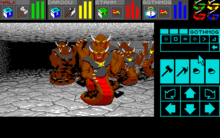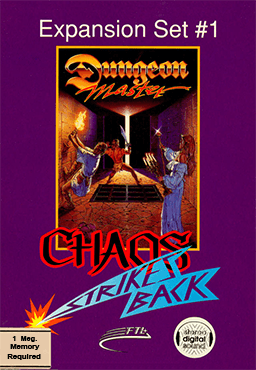Chaos Strikes Back
| Chaos Strikes Back | |
|---|---|
|
Amiga cover art for Chaos Strikes Back | |
| Developer(s) | FTL Games |
| Publisher(s) | FTL Games |
| Platform(s) | Amiga, Atari ST, X68000, PC-98, FM Towns |
| Release date(s) | 1989 |
| Genre(s) | Role-playing game |
| Mode(s) | Single player |
Chaos Strikes Back is an expansion and sequel to Dungeon Master, the earlier 3D real-time action role-playing video game. Chaos Strikes Back was released in 1989[1] and is also available on several platforms (including Atari ST, Amiga, X68000, PC-98, FM Towns). It uses the same engine as Dungeon Master, with new graphics and a new, far more challenging, dungeon.
Description

Although Chaos Strikes Back describes itself as an expansion pack, the original Dungeon Master is not required. Whereas the first game saw the player following a fairly linear path through the adventure, with the completion of each flat level marked by a staircase leading down onto a new slightly harder level below, Chaos Strikes Back features a choice of paths which twist back and forth over all levels. The puzzles are far more convoluted, often demanding quick mastery of the control system to deal with intense combat, along with brain vexing riddles and room layouts.
The game is therefore pitched at a much higher difficulty level than its predecessor. The player can choose from a selection of moderately high-level characters or can import characters from a Dungeon Master saved game. In an indication of the game's uncompromising toughness, the player's very first task is to get out of a dark, enclosed room filled with ferociously toothed man-eating giant worms. The game is made a little easier by the inclusion of a separate program which dispenses cryptic hints based on the player's current saved game.
The player's task is to collect four pieces of corbum, a magical material from which the eponymous Lord Chaos draws his power. This requires the traversing of four separate paths each leading to a piece of corbamite and each themed around one of the disciplines open to characters in the game. These disciplines are fighter, wizard, priest and ninja (as with many role-playing computer games of this period, a great though unacknowledged debt was owed to Dungeons and Dragons, of which Chaos Strikes Back has plenty of both).
Champion Editor

Chaos Strikes Back comes with a utility for editing the portraits and names of the four-character party. This utility allows custom character portraits to be created for both Chaos Strikes Back and for Dungeon Master.
For users who do not want to draw new characters, but who would like more powerful looking versions of the existing characters (to better represent the higher levels), the game's utility disk also comes with "enhanced" versions of the game's prepackaged character art.[2]
Unsolved mystery
While most of the game's various puzzles are solveable, one riddle in particular seems not to be. In the Atari ST version of the game, there is a scroll on which the following words are written: Grynix ernum quey ki skebow rednim u os dey wefna enocarn aquantana. In the Amiga version, this scroll has the magic map spell "Oh Gor Ku". This scroll does not appear in most other versions of the game.
According to Bob Retelle who was a consultant for FTL and wrote hint books for both Dungeon Master and Chaos Strikes Back, this scroll is "another red herring... this was left over from something that was going to be included in the game, but was left out at the last minute... don't worry about it, the scroll can't be decoded."[3]
Legacy
Notable reception received "CSBWin", an Atari ST version based reverse engineered source code reconstruction by Paul R. Stevens around 2003, which led to many ports for modern platforms like Windows and Linux.[4]
Reception
Computer Gaming World stated that Chaos Strikes Back "is no better and no worse than the original game" and "fails to inject any improvement or innovation into the Dungeon Master system". The magazine criticized FTL Games for "resting on its laurels" by producing a "rehash.[5] The game was reviewed in 1991 in Dragon #171 by Hartley, Patricia, and Kirk Lesser in "The Role of Computers" column. The reviewers gave the game 4 out of 5 stars.[6]
See also
- Dungeon Master
- Dungeon Master II: The Legend of Skullkeep
- Dungeon Master: Theron's Quest
- Dungeon Master Nexus
- FTL Games
References
- ↑ Barton, Matt (2007-02-23). "Part 2: The Golden Age (1985-1993)". The History of Computer Role-Playing Games. Gamasutra. Retrieved 2009-03-26.
- ↑ unknown author, "Chaos Strikes Back" Manual, FTL Games, 1989
- ↑ Message from Bob Retelle Jul 21 1990, 9:33 am
- ↑ Walker, John (2012-03-29). "You Could Be Playing Dungeon Master Right Now". Rock, Paper, Shotgun. Retrieved 2015-08-03.
There is a version that just works, without an emulator, and it’s free. [...] A madman by the name of Paul Stevens spent six months, eight hours a day, writing 120,000 lines of what he calls “pseudo-assembly language” to rebuild it in C++. And then released the game and source code for free. Can he do that? I’ve decided that yes, he can, which legitimises my promoting it to you.
- ↑ Godat, Derek (May 1991). "Another Brick in the Wall". Computer Gaming World. p. 38. Retrieved 17 November 2013.
- ↑ Lesser, Hartley; Lesser, Patricia; Lesser, Kirk (July 1991). "The Role of Computers". Dragon (171): 57–64.
External links
- Dungeon Master Encyclopaedia
- 'CSBwin' The original game recompiled for Windows / Linux / MacOS
- 'Return To Chaos' - Dungeon Master, Chaos Strikes Back and new dungeons on Windows
- Chaos Strikes Back Interactive Maps
